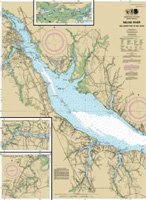Neuse River Information
 The Neuse River has been described as “one of Americas great streams” and also as “one of the widest rivers in the US.” Six nautical miles across at its widest point, it averages over three miles in width between the ICW and New Bern. It is also believed to be one of the oldest rivers in the US. Archeological evidence indicates that early Native Americans settled near the Neuse as early as 14,000 years ago.
The Neuse River has been described as “one of Americas great streams” and also as “one of the widest rivers in the US.” Six nautical miles across at its widest point, it averages over three miles in width between the ICW and New Bern. It is also believed to be one of the oldest rivers in the US. Archeological evidence indicates that early Native Americans settled near the Neuse as early as 14,000 years ago.
From the founding of New Bern by Swiss colonists, the Trent and Neuse Rivers have had a major role in regional growth and development. By the mid 1700’s, New Bern had become a vital port for the new colonies. Nearly seven decades before the American Revolution, the city became a bustling port and the colonial capital.
The waterways of the Neuse and Trent rivers continued to serve as the primary means of transportation for area people, supplies and crops until the late 1800’s. Initially, large flat-bottom boats were used and eventually there regularly-scheduled steamboat service. Today these rivers are famous for water sports, offer great boating and sailing opportunities and the fishing attracts knowledgeable anglers from all over the country.
Neuse River Facts:
• The Neuse flows about 275 miles mostly southeast. At New Bern it is 35 miles to the Atlantic Ocean.
• It is the longest river contained entirely within North Carolina.
• The Neuse river and creeks provide approximately 2,750 acres of prime fish nursery habitat and 1,250 acres of secondary fish nursery habitats.
• The Neuse river’s current is fast moving for 150 miles from its source, west of Raleigh, until it reaches western Craven County and becomes a slow-moving brackish estuary that continues for another 40 miles & flows into the Pamlico Sound.
• There is a clearly marked channel from the Intracoastal Waterway (ICW) to New Bern. Natural channel depths range between 8 and 12 feet with little noticeable tidal effect.